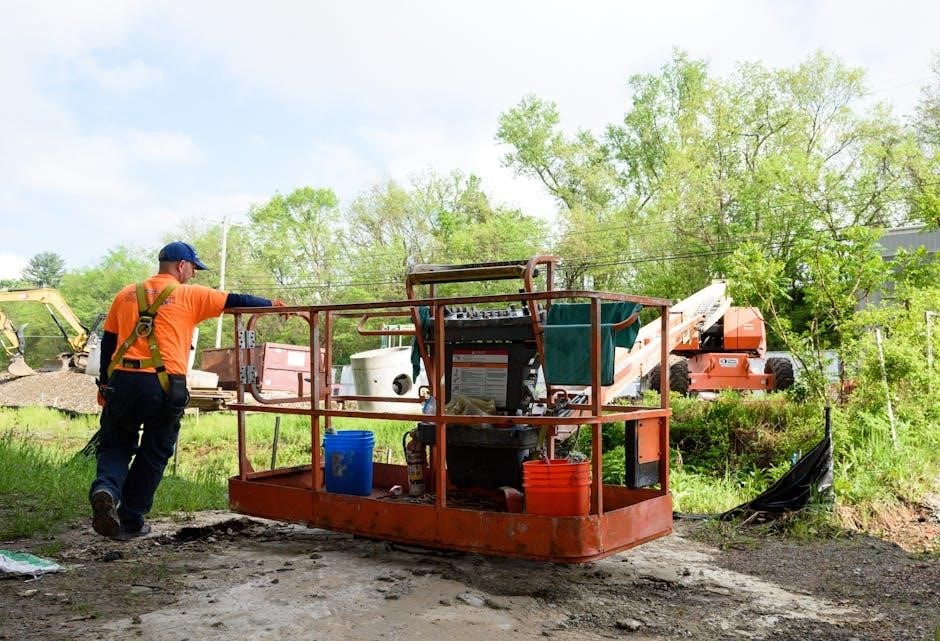
Manual Cranes: An Overview
Manual cranes are portable, human-powered lifting devices used in workshops, construction, and light industrial settings. They provide mechanical advantage, enabling easy lifting of small to medium loads.
Manual cranes are simple, cost-effective lifting devices operated by human power, ideal for light-duty applications. They are widely used in workshops, construction sites, and small industries due to their portability and ease of use. These cranes rely on manual effort to lift and move loads, making them versatile tools for various tasks. Unlike motorized cranes, manual cranes are quieter, require minimal maintenance, and are environmentally friendly. They are particularly suited for situations where electricity is unavailable or where space is limited. Manual cranes are also preferred for their affordability and simplicity, making them accessible to a broad range of users. Their design emphasizes ease of operation and safety, ensuring efficient load handling in diverse settings.
1.2 Types of Manual Cranes
Manual cranes come in several types, each designed for specific applications. The most common include hand-crank cranes, which use a rotating handle to lift loads, and lever-operated cranes, utilizing a lever for easier lifting. Pull-push cranes are simple, requiring a manual push or pull to move loads along a beam. Floor cranes are portable, with a sturdy base for stability, while gantry cranes are overhead systems suitable for heavier loads. Each type offers unique advantages, such as portability, ease of use, or load capacity, making manual cranes versatile tools across various industries. Understanding the differences helps users choose the most suitable crane for their needs, ensuring efficient and safe load handling in different environments.

Components of a Manual Crane
Manual cranes consist of a durable frame, a lifting mechanism with pulleys and cables, manual controls like cranks or levers, and often wheels or casters for mobility. A brake system ensures load stability.
2.1 The Frame and Structure
The frame and structure of a manual crane are designed for durability and stability, typically constructed from high-strength materials like steel or aluminum. The frame serves as the crane’s backbone, providing the necessary rigidity to support loads without bending or warping. In many models, the structure is lightweight yet robust, ensuring portability without compromising strength. The base of the crane is often wide and equipped with stabilizing features to prevent tipping during operation. Some manual cranes feature foldable or adjustable frames, making them versatile for various work environments. The structural integrity is critical, as it directly impacts the crane’s safety and lifting capacity. Proper alignment and assembly of the frame ensure smooth operation and longevity of the equipment.
2.2 The Lifting Mechanism
The lifting mechanism of a manual crane is its core functional component, designed to translate human effort into lifting force. Typically, it consists of a pulley system, levers, and cables or chains. These elements work together to provide mechanical advantage, reducing the effort required to lift heavy loads. The mechanism often incorporates a hand-operated winch or crank, allowing users to manually raise or lower the load. The pulleys and gears are precision-engineered to ensure smooth, efficient operation, while the rope or chain provides the necessary tension and control. Safety features, such as overload protection and braking systems, are integral to the lifting mechanism to prevent accidents and ensure reliable performance. Regular lubrication of moving parts is essential to maintain the mechanism’s efficiency and longevity.
2.3 Manual Controls and Operation
Manual cranes are operated using a combination of levers, cranks, or handles that engage the lifting mechanism. These controls are designed for ease of use, allowing a single person to manage the crane effectively. The operation typically involves turning a hand crank or moving a lever to activate the pulley system, which then lifts or lowers the load. Safety features, such as braking systems, are often integrated into the controls to prevent unintended movement. Regular maintenance of the controls, including lubrication and inspection, is essential to ensure smooth operation. The simplicity of manual controls makes these cranes accessible to operators without extensive training, providing a reliable and efficient solution for light-duty lifting tasks;
Working Principle of Manual Cranes
Manual cranes operate using mechanical advantage, where human effort is amplified through levers or pulleys to lift loads. They rely on manual operation, typically via cranks or handles, to engage the lifting mechanism, making them portable and ideal for small-scale applications.
3.1 Mechanical Advantage and Leverage
Manual cranes utilize the principle of mechanical advantage through levers and pulleys, reducing the effort required to lift loads. By applying force at a distance from the fulcrum, users gain leverage, making it easier to handle heavy objects. The system amplifies the applied force, enabling efficient lifting with minimal strain. This principle is crucial for maintaining portability and ease of use in various applications. The design ensures that the force is distributed evenly, enhancing safety and control during operations. Mechanical advantage is a key feature that makes manual cranes indispensable in workshops and construction sites.
3.2 Lifting and Lowering Loads
Manual cranes are designed to lift and lower loads efficiently, relying on the operator’s input to control the movement. The lifting mechanism, typically operated by a handle or lever, engages a system of pulleys and cables to hoist loads. Proper alignment and balance are crucial to ensure smooth operation and prevent accidents. Operators must maintain control throughout the process, using the crane’s mechanical advantage to maneuver loads with precision. The process involves gradual lifting and careful lowering, often guided by visual cues or team coordination. This method ensures safe and accurate placement of loads, making manual cranes versatile tools in various industrial and construction environments.
Safety Considerations
Proper training, load limits, and equipment inspection are critical for safe manual crane operation. Always follow guidelines to prevent accidents and ensure secure load handling.
4.1 Safety Guidelines for Operation
Operating a manual crane safely requires adhering to specific guidelines. First, ensure the crane is on a stable, level surface and properly assembled. Always inspect the crane for damage or wear before use. Load testing is essential to verify the crane’s capacity. Operators must be trained and aware of load limits to prevent overloading, which can lead to mechanical failure. Use proper lifting techniques to avoid strain. Never leave a loaded crane unattended, and ensure the surrounding area is clear of obstacles and people. Regular lubrication of moving parts and timely replacement of worn components are crucial for smooth operation. Compliance with manufacturer instructions and workplace safety standards is non-negotiable to ensure safe and efficient crane operation.
4.2 Maintenance and Inspection Practices
Regular maintenance and thorough inspections are critical to ensure the safe and efficient operation of manual cranes. Start with daily checks: lubricate moving parts, inspect wire ropes for fraying, and verify chain tensions. Examine the crane’s frame for any structural damage or corrosion. Apply grease to pivot points and axles periodically to maintain smooth operation. Conduct load tests every six months to confirm the crane’s capacity. Replace worn components immediately, such as brake pads or faulty bearings, to prevent accidents. Keep the crane clean and free from debris to avoid interference with mechanical components. Store the crane in a dry, protected area when not in use to prevent rust. Following these practices ensures reliability, extends the crane’s lifespan, and maintains workplace safety.

Applications of Manual Cranes
Manual cranes are widely used in workshops, warehouses, and construction sites for lifting and moving materials efficiently. They are ideal for small-scale, precise operations.
5.1 Industries That Use Manual Cranes
Manual cranes are essential tools across various industries due to their portability and ease of use. In construction, they are used for lifting building materials. Warehouses and logistics facilities rely on them for moving goods efficiently. Automotive repair shops utilize manual cranes to lift vehicles or heavy parts. Manufacturing plants employ them for handling equipment and components. Additionally, shipyards and small engineering workshops use manual cranes for maintenance and assembly tasks. Their versatility and affordability make them a preferred choice in these sectors, ensuring safe and precise lifting operations even in confined spaces.


Maintenance and Troubleshooting
Regular maintenance ensures manual cranes operate safely and efficiently. Lubricate moving parts, inspect wire ropes, and replace worn components promptly. Address issues quickly to prevent breakdowns.
6.1 Routine Maintenance Tasks
Regular maintenance ensures manual cranes function safely and efficiently. Inspect the wire rope for frays or wear, and replace it if damaged. Lubricate moving parts like pulleys and gears to reduce friction and prevent corrosion. Check the brake system for proper engagement and adjust if necessary. Clean the crane regularly to remove dirt and debris that could interfere with operation. Test the load limit periodically to ensure it operates within safe parameters. Replace any worn or damaged components, such as hooks or bearings, promptly. Keep a maintenance log to track inspections and repairs, ensuring compliance with safety standards. Always follow the manufacturer’s guidelines for specific maintenance procedures to extend the crane’s lifespan and prevent unexpected failures.
Manual cranes are versatile tools offering efficiency and safety for lifting tasks in various industries. Their portability and ease of use make them ideal for workshops, construction sites, and light industrial applications. Proper maintenance and operation ensure longevity and reliability, while adherence to safety guidelines minimizes risks. By understanding their components, working principles, and applications, users can maximize their utility. Regular inspections and timely repairs are crucial for sustained performance. Manual cranes remain essential equipment for businesses requiring cost-effective, manual lifting solutions, providing dependable service when maintained correctly.